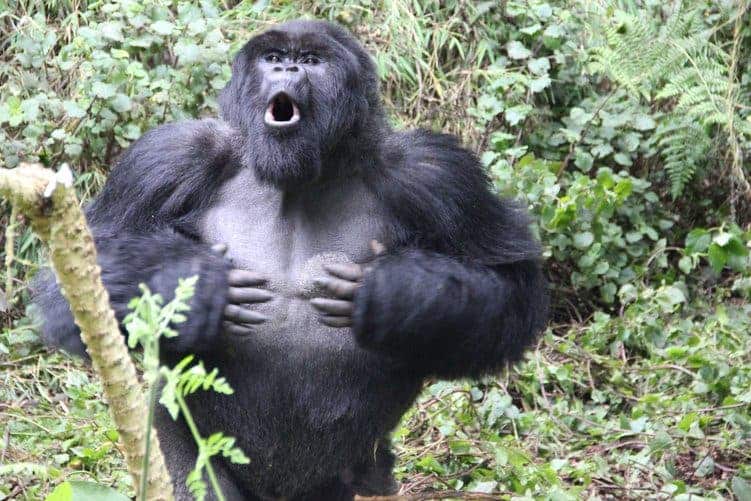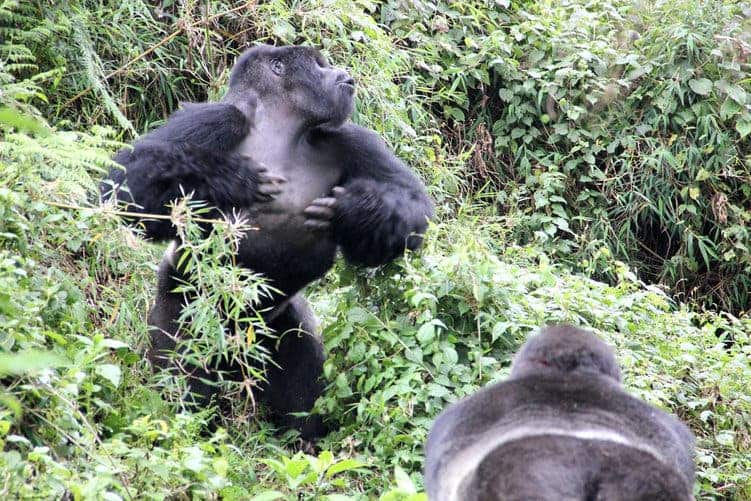
The sight of a gorilla beating its chest is one of the most iconic in the animal kingdom. There’s been a ton of speculation as to why these great apes engage in this behavior. Does it intimidate rivals or attract potential mates? Surprisingly, there’s been little formal evidence to confirm these hypotheses — until now.
Primatologists at the Max Planck Institute for Evolutionary Anthropology in Germany spent more than 3,000 hours observing mountain gorillas at Volcanoes National Park in Rwanda. Their observations, which were reported in the journal Scientific Reports, show that the frequency of the chest beats mirror the body size of the chest beater. Among gorillas, body size is an indicator of dominance and reproductive success, so the chest-beating can be seen as an ‘honest signal’ of these characteristics. It tells potential rivals “stay away!” and would-be mates “I’m your man!”.
One of Africa’s most emblematic sounds
Forget about King Kong for a second. Everything you know about gorillas is probably wrong anyway. When gorillas are about to beat their chest, they’ll typically stand upright and rapidly beat their chest. They won’t use their fists like you see in the movies but rather rapidly beat their chests with cupped hands in rapid succession.
The rapid thumbs can be heard over one kilometer away, although the researchers recorded these frequencies from much closer. They recorded the audio of over 500 chest beats from 25 different males between 2014 and 2016. They also photographed each male, so they could perform body measurements. Recording chest beats that can last just a few seconds proved challenging, as well as staying clear of these powerful animals that can easily reach 500 pounds.
When the researchers compared the recordings to the apes’ sizes, they found that the biggest males produced sounds with lower frequencies. This is perhaps due to the fact that larger individuals also possess larger air sacs near their larynx. Similar to an alligator’s rumble or a bison’s bellow, these low-frequency sounds could thus describe a male’s size to others without having to be close enough to convey this information visually.
“It is great that we have been able to show that body size is encoded in these spectacular displays,” says Edward Wright, the first author of the study from the Max Planck Institute for Evolutionary Anthropology in Leipzig, Germany.
Previous research established that gorilla size is closely associated with social dominance and reproductive success. As such, a rival male hearing the chest beats can assess the competitive ability of the chest beater. Although male gorillas can be highly aggressive, physical confrontations between males are rare. These chest beats may be one of many ways that dominant male gorillas employ to keep contenders in line.
Although each male beat their chest an average of just 1.6 times every 10 hours, bigger, more dominant males struck their chest more often and for longer.

But it’s not just other males that should take notice of a proper chest beat. Females also have plenty of good reasons to listen to these displays, which could guide them towards the most appealing potential mate. Although this particular study hasn’t studied chest-beating as a courting display, scientists know from previous observations of silverback gorillas that males beat their chests most often when females are entering estrus, the phase when the female is sexually receptive (“in heat”).
Interestingly enough, the observations also revealed a great deal of variation among males in terms of the number of beats, as well as their duration.
“This hints at the possibility that chest beats may have individual signatures, but further study is needed to test this,” says Wright.
The findings appeared in the journal Scientific Reports.






